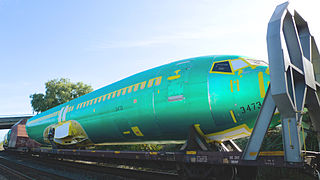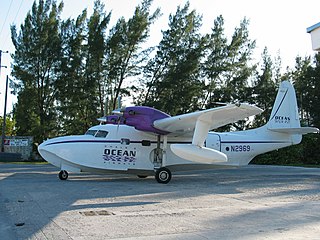Applications
Crack arrestors have seen extensive use in the aviation sector, particularly upon large pressurised aircraft as a means of guarding against progressive metal fatigue. [3] Specifically, the skin of the fuselage typically has a large number of high stress locations, rivetting being a leading cause, making these points of potential crack initiation. Calculations are frequently used to simulate crack propagation, as well as the effectiveness of mitigating measures, such as crack arrestors, in ensuring the aircraft can be safely operated. [3]
Following two catastrophic airframe failures in 1954, crack arrestors were used as additional reinforcement of the fuselage of the de Havilland Comet, although this was only one of several design changes made to address structural design weaknesses related to metal fatigue and skin stresses that had been previously unknown to the aviation industry. [4] [5]
Naval vessels are another place where crack arrestors have been extensively used. As of the 2010s, the United States Navy frequently applies them to areas of the ship that have been damaged or otherwise have received repairs in order to ensure that the affected element is not lacking in either strength or durability. It has been acknowledged that ships primarily composed of aluminium are significantly more prone to crack propagation than older steel counterparts; thus, the use of mitigating measures is likely to become more commonplace. [6]
Crack arrestors have also been used in civil engineering. They have long been used in the nuclear industry as a structural element of reactors. [7] Numerous pipelines used from transporting chemicals have been reinforced with such devices to protect against bursting and exterior damage alike. [8] While commonly applied to metal alloys, appropriately designed crack arrestors have been used with composite materials as well. [9] [10] During 2008, Airbus Group was awarded a patent for a new design technique for a crack arrestor component. [11]

The fuselage is an aircraft's main body section. It holds crew, passengers, or cargo. In single-engine aircraft, it will usually contain an engine as well, although in some amphibious aircraft the single engine is mounted on a pylon attached to the fuselage, which in turn is used as a floating hull. The fuselage also serves to position the control and stabilization surfaces in specific relationships to lifting surfaces, which is required for aircraft stability and maneuverability.

The de Havilland DH.106 Comet was the world's first commercial jet airliner. Developed and manufactured by de Havilland in the United Kingdom, the Comet 1 prototype first flew in 1949. It featured an aerodynamically clean design with four de Havilland Ghost turbojet engines buried in the wing roots, a pressurised cabin, and large windows. For the era, it offered a relatively quiet, comfortable passenger cabin and was commercially promising at its debut in 1952.

Fracture is the separation of an object or material into two or more pieces under the action of stress. The fracture of a solid usually occurs due to the development of certain displacement discontinuity surfaces within the solid. If a displacement develops perpendicular to the surface, it is called a normal tensile crack or simply a crack; if a displacement develops tangentially, it is called a shear crack, slip band or dislocation.

In materials science, fatigue is the initiation and propagation of cracks in a material due to cyclic loading. Once a fatigue crack has initiated, it grows a small amount with each loading cycle, typically producing striations on some parts of the fracture surface. The crack will continue to grow until it reaches a critical size, which occurs when the stress intensity factor of the crack exceeds the fracture toughness of the material, producing rapid propagation and typically complete fracture of the structure.

The mechanical structure of an aircraft is known as the airframe. This structure is typically considered to include the fuselage, undercarriage, empennage and wings, and excludes the propulsion system.

Aloha Airlines Flight 243 was a scheduled Aloha Airlines flight between Hilo and Honolulu in Hawaii. On April 28, 1988, a Boeing 737-297 serving the flight suffered extensive damage after an explosive decompression in flight, caused by part of the fuselage breaking due to poor maintenance and metal fatigue. The plane was able to land safely at Kahului Airport on Maui. The one fatality, flight attendant Clarabelle "C.B." Lansing, was ejected from the airplane. Another 65 passengers and crew were injured. The substantial damage inflicted by the decompression, the loss of one cabin crew member, and the safe landing of the aircraft established the incident as a significant event in the history of aviation, with far-reaching effects on aviation safety policies and procedures.

In solid mechanics, a stress concentration is a location in an object where the stress is significantly greater than the surrounding region. Stress concentrations occur when there are irregularities in the geometry or material of a structural component that cause an interruption to the flow of stress. This arises from such details as holes, grooves, notches and fillets. Stress concentrations may also occur from accidental damage such as nicks and scratches.

Glare is a fiber metal laminate (FML) composed of several very thin layers of metal interspersed with layers of S-2 glass-fiber pre-preg, bonded together with a matrix such as epoxy. The uni-directional pre-preg layers may be aligned in different directions to suit predicted stress conditions.
In engineering, damage tolerance is a property of a structure relating to its ability to sustain defects safely until repair can be effected. The approach to engineering design to account for damage tolerance is based on the assumption that flaws can exist in any structure and such flaws propagate with usage. This approach is commonly used in aerospace engineering, mechanical engineering, and civil engineering to manage the extension of cracks in structure through the application of the principles of fracture mechanics. A structure is considered to be damage tolerant if a maintenance program has been implemented that will result in the detection and repair of accidental damage, corrosion and fatigue cracking before such damage reduces the residual strength of the structure below an acceptable limit.

Cabin pressurization is a process in which conditioned air is pumped into the cabin of an aircraft or spacecraft in order to create a safe and comfortable environment for humans flying at high altitudes. For aircraft, this air is usually bled off from the gas turbine engines at the compressor stage, and for spacecraft, it is carried in high-pressure, often cryogenic, tanks. The air is cooled, humidified, and mixed with recirculated air by one or more environmental control systems before it is distributed to the cabin. The cabin pressure is regulated by the outflow valve.
In safe-life design, products are intended to be removed from service at a specific design life.

Chalk's Ocean Airways Flight 101 was an aircraft crash that occurred off Miami Beach, Florida, in the United States on December 19, 2005. All 18 passengers and the 2 crew members on board the 1947 Grumman G-73T Turbine Mallard died in the crash, which was attributed to metal fatigue on the starboard wing resulting in separation of the wing from the fuselage.
In materials science, environmental stress fracture or environment assisted fracture is the generic name given to premature failure under the influence of tensile stresses and harmful environments of materials such as metals and alloys, composites, plastics and ceramics.

In a fixed-wing aircraft, the spar is often the main structural member of the wing, running spanwise at right angles to the fuselage. The spar carries flight loads and the weight of the wings while on the ground. Other structural and forming members such as ribs may be attached to the spar or spars, with stressed skin construction also sharing the loads where it is used. There may be more than one spar in a wing or none at all. Where a single spar carries most of the force, it is known as the main spar.
The wingbox of a fixed-wing aircraft refers to the primary load-carrying structure of the wing, which forms the structural centre of the wings and also the attachment point for other wing components such as leading edge flaps, trailing edge flaps and wing-tip devices. The wingbox continues beyond the visible wing roots and interfaces with the fuselage in the centre wingbox, which forms the structural core of an aircraft.

Engineering disasters often arise from shortcuts in the design process. Engineering is the science and technology used to meet the needs and demands of society. These demands include buildings, aircraft, vessels, and computer software. In order to meet society’s demands, the creation of newer technology and infrastructure must be met efficiently and cost-effectively. To accomplish this, managers and engineers need a mutual approach to the specified demand at hand. This can lead to shortcuts in engineering design to reduce costs of construction and fabrication. Occasionally, these shortcuts can lead to unexpected design failures.
Polymer fracture is the study of the fracture surface of an already failed material to determine the method of crack formation and extension in polymers both fiber reinforced and otherwise. Failure in polymer components can occur at relatively low stress levels, far below the tensile strength because of four major reasons: long term stress or creep rupture, cyclic stresses or fatigue, the presence of structural flaws and stress-cracking agents. Formations of submicroscopic cracks in polymers under load have been studied by x ray scattering techniques and the main regularities of crack formation under different loading conditions have been analyzed. The low strength of polymers compared to theoretically predicted values are mainly due to the many microscopic imperfections found in the material. These defects namely dislocations, crystalline boundaries, amorphous interlayers and block structure can all lead to the non-uniform distribution of mechanical stress.
Materials that are used for biomedical or clinical applications are known as biomaterials. The following article deals with fifth generation biomaterials that are used for bone structure replacement. For any material to be classified for biomedical applications, three requirements must be met. The first requirement is that the material must be biocompatible; it means that the organism should not treat it as a foreign object. Secondly, the material should be biodegradable ; the material should harmlessly degrade or dissolve in the body of the organism to allow it to resume natural functioning. Thirdly, the material should be mechanically sound; for the replacement of load-bearing structures, the material should possess equivalent or greater mechanical stability to ensure high reliability of the graft.
Solder fatigue is the mechanical degradation of solder due to deformation under cyclic loading. This can often occur at stress levels below the yield stress of solder as a result of repeated temperature fluctuations, mechanical vibrations, or mechanical loads. Techniques to evaluate solder fatigue behavior include finite element analysis and semi-analytical closed-form equations.

Fatigue testing is a specialised form of mechanical testing that is performed by applying cyclic loading to a coupon or structure. These tests are used either to generate fatigue life and crack growth data, identify critical locations or demonstrate the safety of a structure that may be susceptible to fatigue. Fatigue tests are used on a range of components from coupons through to full size test articles such as automobiles and aircraft.












